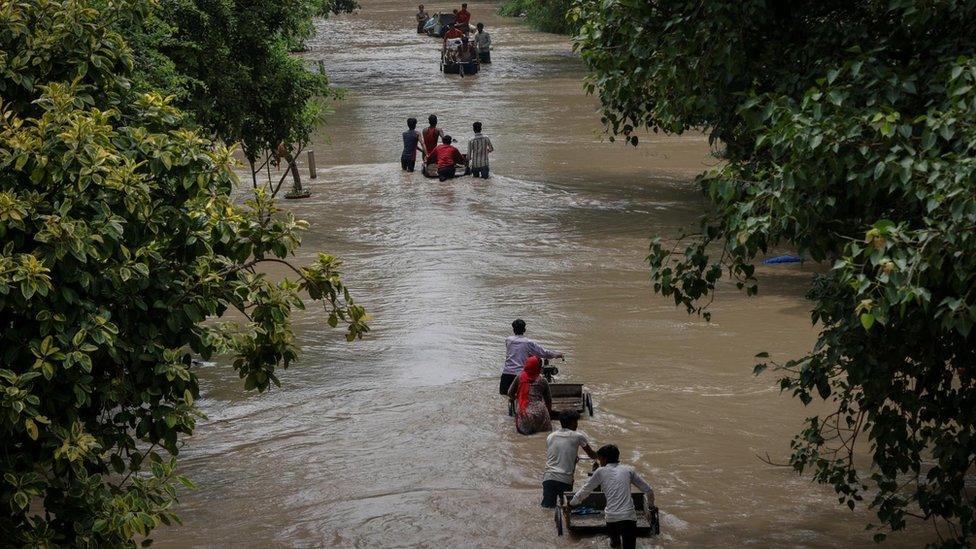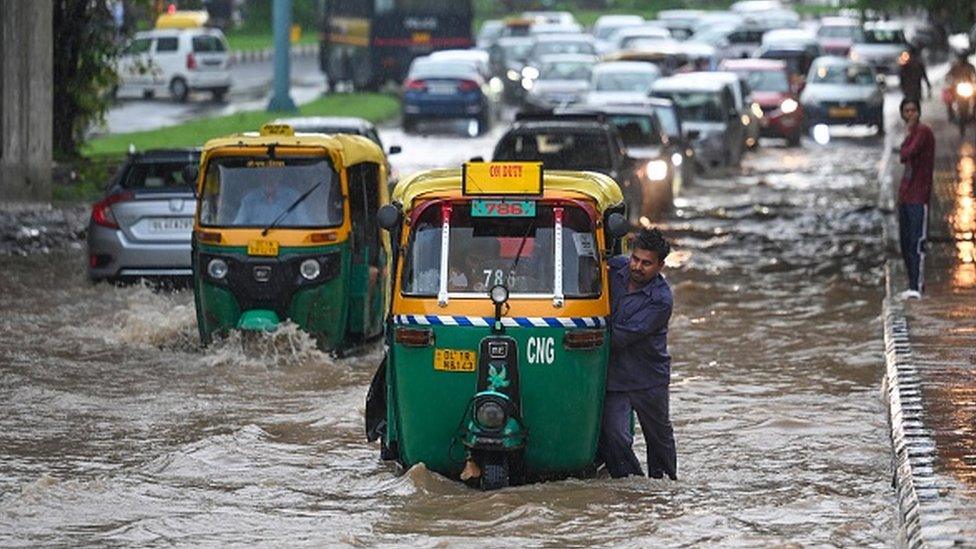Delhi floods: Key roads under water as Yamuna river swells
- Published
Watch: Drone shows large chunks of highway destroyed in India flooding
Key roads in the Indian capital, Delhi, have been flooded as water from the Yamuna river has overflowed onto them.
The water level of the river has been rising since Wednesday after it breached an all-time high mark in more than 45 years.
Authorities have evacuated thousands from nearby low-lying areas and have diverted traffic from arterial roads.
Northern India has witnessed record rainfall so far this monsoon season, which began in June, officials say.
At least 88 people have died in Himachal Pradesh since rains began late last month, while nearby states like Punjab and Haryana have also been witnessing severe flooding.
On Thursday morning, the water level of Yamuna had risen to 208.46 metres from 207.49 metres, external the previous day - the highest in 45 years, authorities said.
Water from the swelling river has inundated several low-lying areas and roads. Videos shared on social media show cars and buses submerged under water on the streets.
Footage from local TV channels showed the street outside Chief Minister Arvind Kejriwal's home flooded, while PTI news agency reported, external that a key road going towards Connaught Place - a popular business centre in central Delhi - was also flooded.
Mr Kejriwal told, external reporters on Thursday that schools, colleges and universities in the capital would remain shut until Sunday. He added that government employees, except those providing essential services, could work from home.
"Advisory is being issued for private offices too to work from home," he added.
Three water treatment plants in Delhi have been shut due to the flood-like situation. Mr Kejriwal has said that water will have to be rationed and so people were likely to face shortages for a couple of days.
Heavy vehicles, except those providing essential services, have been banned from entering Delhi.
More than 16,000 people have been shifted to relief tents pitched under flyovers by the Delhi government.
Disaster relief teams have been deployed in several regions and rescue efforts are ongoing in flooded areas.
On Wednesday, Mr Kejriwal said he had asked the federal government to control the amount of water being released from Hathnikund Barrage in Haryana, which he said was causing the Yamuna to swell.
Authorities have said that the flow of water from the barrage will begin subsiding by 14:00 IST (08.30 GMT) on Thursday, and this should bring some respite to flooded areas.
The state's governor and Mr Kejriwal met the Delhi Disaster Management Authority on Thursday to discuss the flood situation.

The river Yamuna has risen to a 45-year high, according to Delhi's chief minister
Seasonal monsoon rains are a lifeline for India but also typically cause deaths and destruction to property every year.
India has experienced increasingly extreme weather in recent years - the unrelenting rains come just weeks after an extreme heat wave gripped most of north India.
Many factors contribute to flooding, but experts say climate change caused by global warming makes extreme rainfall more likely.

How does the Indian monsoon happen?
BBC News India is now on YouTube. Click here, external to subscribe and watch our documentaries, explainers and features.

Read more India stories from the BBC:

- Published11 July 2023
